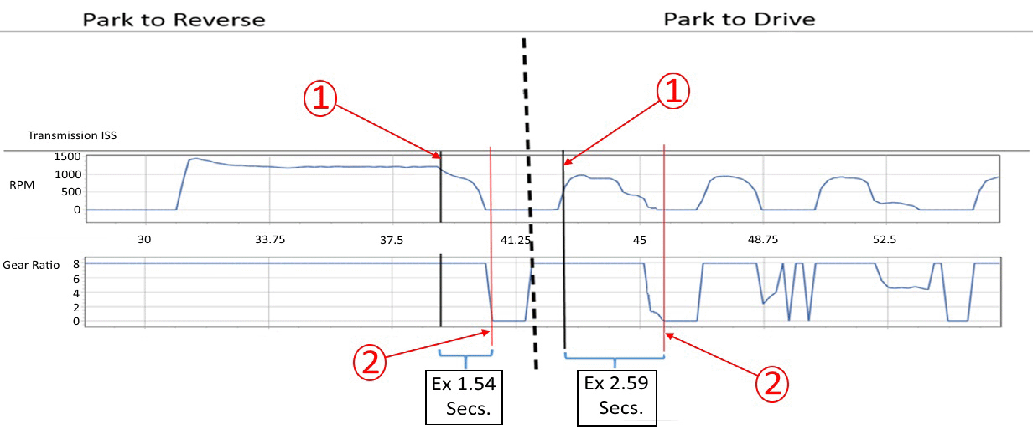2015 - 2017 Corvette: Service Bulletin: #16-NA-364: Delayed Engagement After Sitting With Engine Off - Clutch Slow to Fill
Estimated Reading Time: 4 Minutes#16-NA-364: Delayed Engagement After Sitting With Engine Off - Clutch Slow to Fill - (Jun 29, 2017)
| Subject: | Delayed Engagement After Sitting With Engine Off - Clutch Slow to Fill |
|
Brand: |
Model: |
Model Year: |
VIN: |
Engine: |
Transmission: | ||
|---|---|---|---|---|---|---|---|
|
from |
to |
from |
to | ||||
|
Cadillac |
Escalade |
2015 |
2017 |
8L90 (M5U, M5X) |
|||
|
ATS |
2016 |
2017 |
8L45, 8L90 (M5N, M5T, M5U) |
||||
|
CTS |
2016 |
2017 |
8L45, 8L90 (M5N, M5T, M5U) |
||||
|
CT6 |
2016 |
2017 |
8L45, 8L90 (M5N, M5X) |
||||
|
Chevrolet |
Camaro |
2016 |
2017 |
8L45, 8L90 (M5T, M5U) |
|||
|
Corvette |
2015 |
2017 |
8L90 (M5U) |
||||
|
Colorado |
2017 |
2017 |
8L45 (M5T) |
||||
|
Silverado |
2015 |
2017 |
8L90 (M5U, M5X) |
||||
|
Suburban |
2017 |
2017 |
8L90 (M5U, M5X) |
||||
|
Tahoe |
2017 |
2017 |
8L90 (M5U, M5X) |
||||
|
GMC |
Canyon |
2017 |
2017 |
8L45 (M5T) |
|||
|
Sierra |
2015 |
2017 |
8L90 (M5U, M5X) |
||||
|
Yukon |
2015 |
2017 |
8L90 (M5U, M5X) |
||||
|
Involved Region or Country |
North America and N.A. Export Regions |
|
Condition |
Some customers may comment on a condition of delayed engagement when the transmission is shifted from Park to Reverse or Park to Drive after the vehicle has been sitting with the engine off. This condition may typically occur after several hours or more commonly overnight. Customers may describe this condition as:
Operation will be normal for the subsequent engagements throughout the day and the condition will not occur until the vehicle sits again with the engine off for several hours or overnight. |
- Delayed Harsh Engagement - Clutch Slow to Fill
-
Note: Vehicle should only be evaluated if sitting for a minimum of 8 hours but less than 24 hours. To be measured at 50° F (10° C) and above.
Delayed Engagement Park to Reverse or Drive is present if the time difference between Gear Selected (Pt. 1) and Transmission Input Shaft Speed reaching 0 RPMs (Pt. 2) exceeds 3 seconds. Foot is HELD on Brake during maneuver.

The slide bar on the bottom left of GDS2 Screen can be used to aid in discerning time (Pt. 2 – Pt. 1) = Delayed Engagement Time.
If the customer describes the condition as a long engagement time with a harsh or bump engagement feel when shifting the vehicle from Park to Drive or Reverse, use GDS and monitor engine RPM and the transmission Input Speed Sensor (ISS) prior to starting the engine. Start the engine with the transmission in Park. The ISS should equal engine RPM in 2 seconds or less. If the ISS takes more than 2 seconds to equal engine RPM, then follow the procedure for replacing the stator shaft support (Refer to Bulletin 16-NA-014). If the ISS is equal to engine RPM in 2 seconds or less, shift the vehicle from Park to Drive or Reverse leaving the service brake applied. The ISS should drop to zero “0’ within 3 seconds; this is clutch engagement time. Recording a GDS session log can be useful in diagnosing this condition.
Note: This procedure will allow the pressures to adapt and improve the engagement time to Reverse.
For 2015 MY vehicles, disassemble the transmission and inspect the 1-3-5-6-7 Clutch (C3) for a delay into Drive and inspect the 4-5-6-7-8 Reverse Clutch (C5) for a delay into Reverse. The respective clutch plates and seals should be inspected for wear and or damage.
- If an issue is not discovered during disassembly, the transmission should be replaced. GDS should be used to confirm the actual transmission clutch engagement time of 3 seconds or longer prior to disassembly.
For 2016-2017 MY vehicles, attempt to learn the C5 - Reverse and C3 - Drive Clutch using the following procedure:
- Allow the transmission sump temperature to rise between 20° and 30°C (68° and 86°F).
Note: Do NOT apply the accelerator pedal.
- Perform 20 Park to Reverse shifts or 20 Park to Drive shifts releasing the brake pedal with each shift allowing the vehicle to roll 5-10 feet per engagement into gear.
If the learn procedure does not correct the condition, disassemble the transmission and inspect the 1-3-5-6-7 Clutch (C3) for a delay into Drive and inspect the 4-5-6-7-8 Reverse Clutch (C5) for a delay into Reverse. The respective clutch plates and seals should be inspected for wear and or damage.
- If an issue is not discovered during disassembly, the transmission should be replaced. GDS should be used to confirm the actual transmission clutch engagement time of 3 seconds or longer prior to disassembly.
- Warranty Information
-
For vehicles repaired under the Powertrain coverage, use the following labor operation. Reference the Applicable Warranties section of Investigate Vehicle History (IVH) for coverage information.
Labor Operation
Year
Description
Labor Time
8465362
2015
2-3-4-6-8 and 4-5-6-7-8 Reverse Clutch Assembly Overhaul
Use Published Labor Operation Time
8464670
2015-2017
Transmission Inspection and Replacement
Use Published Labor Operation Time
8480318*
2016-2017
Drive Learn Procedure
Straight Time
*This is a unique Labor Operation for Bulletin use only.
Version
2
Modified
June 29, 2017 - Added the CT6, Colorado and Canyon models.